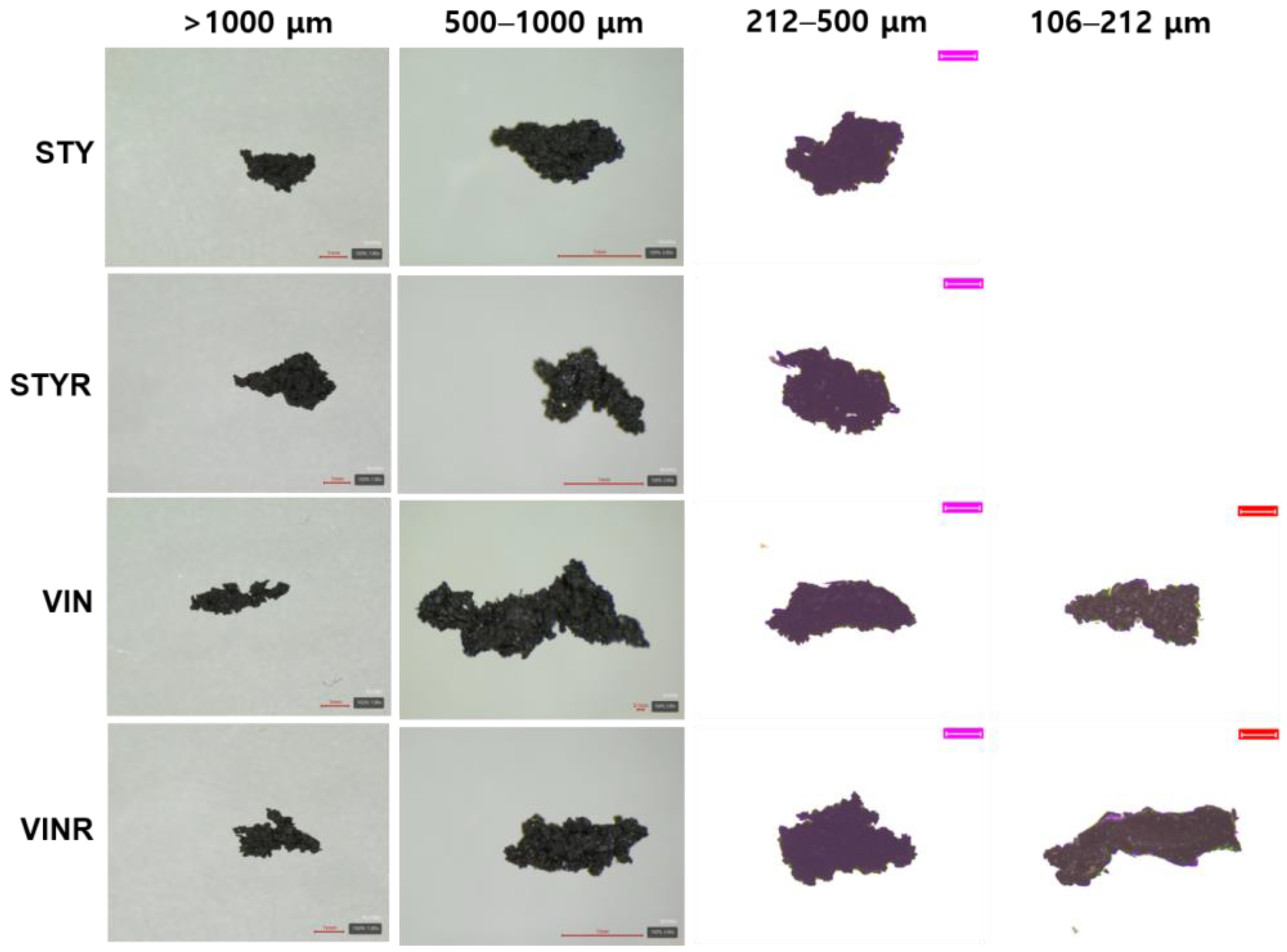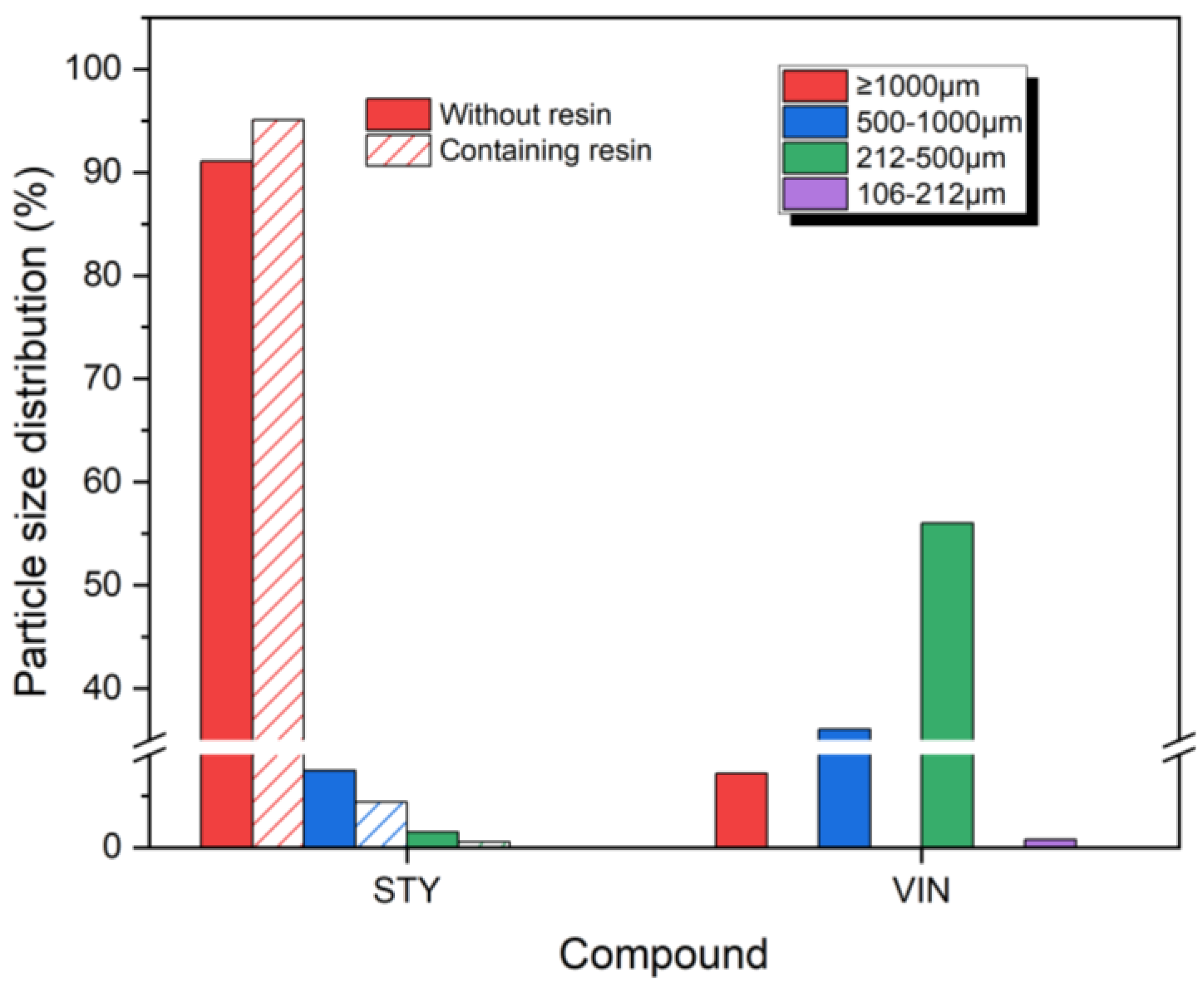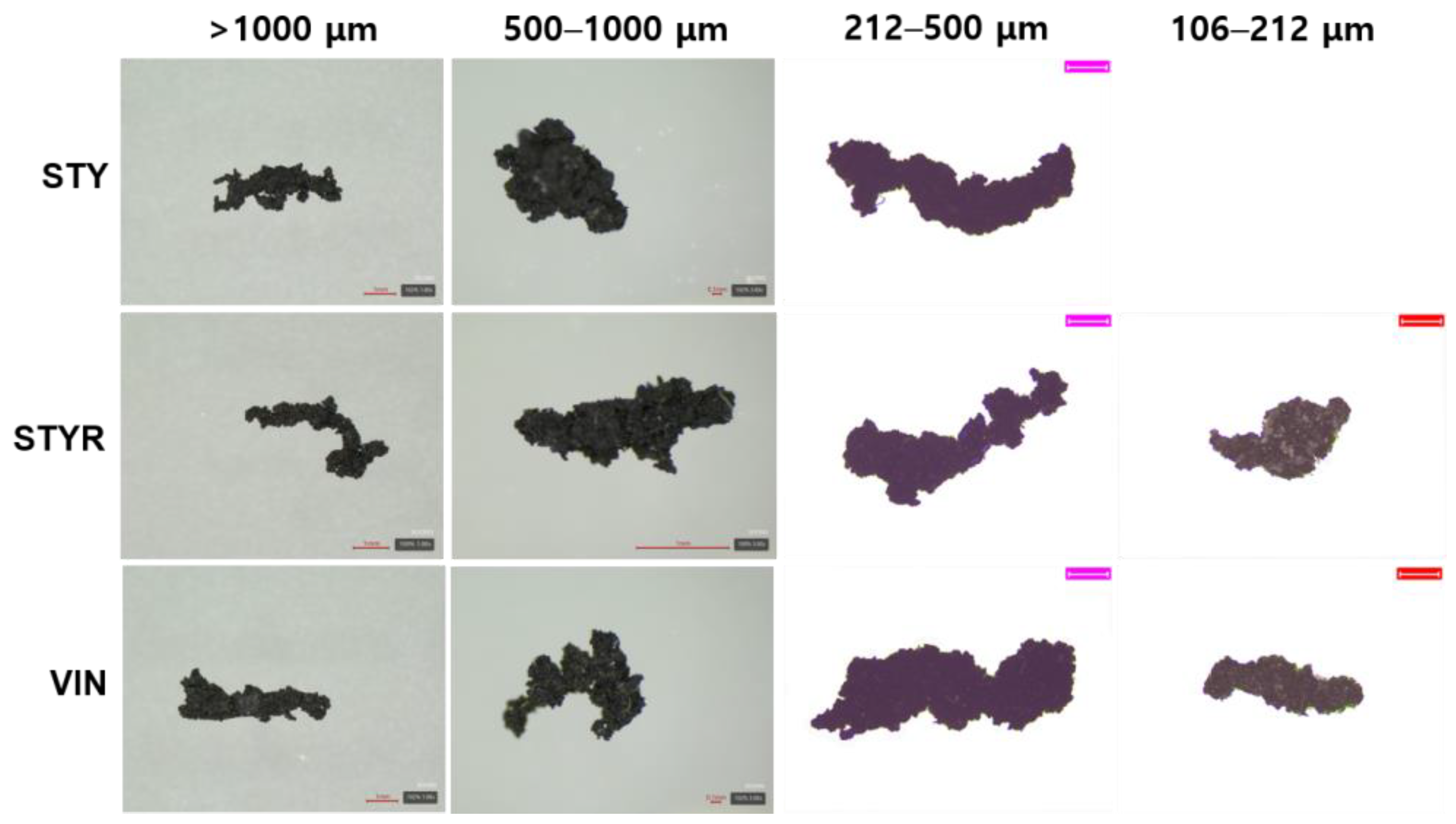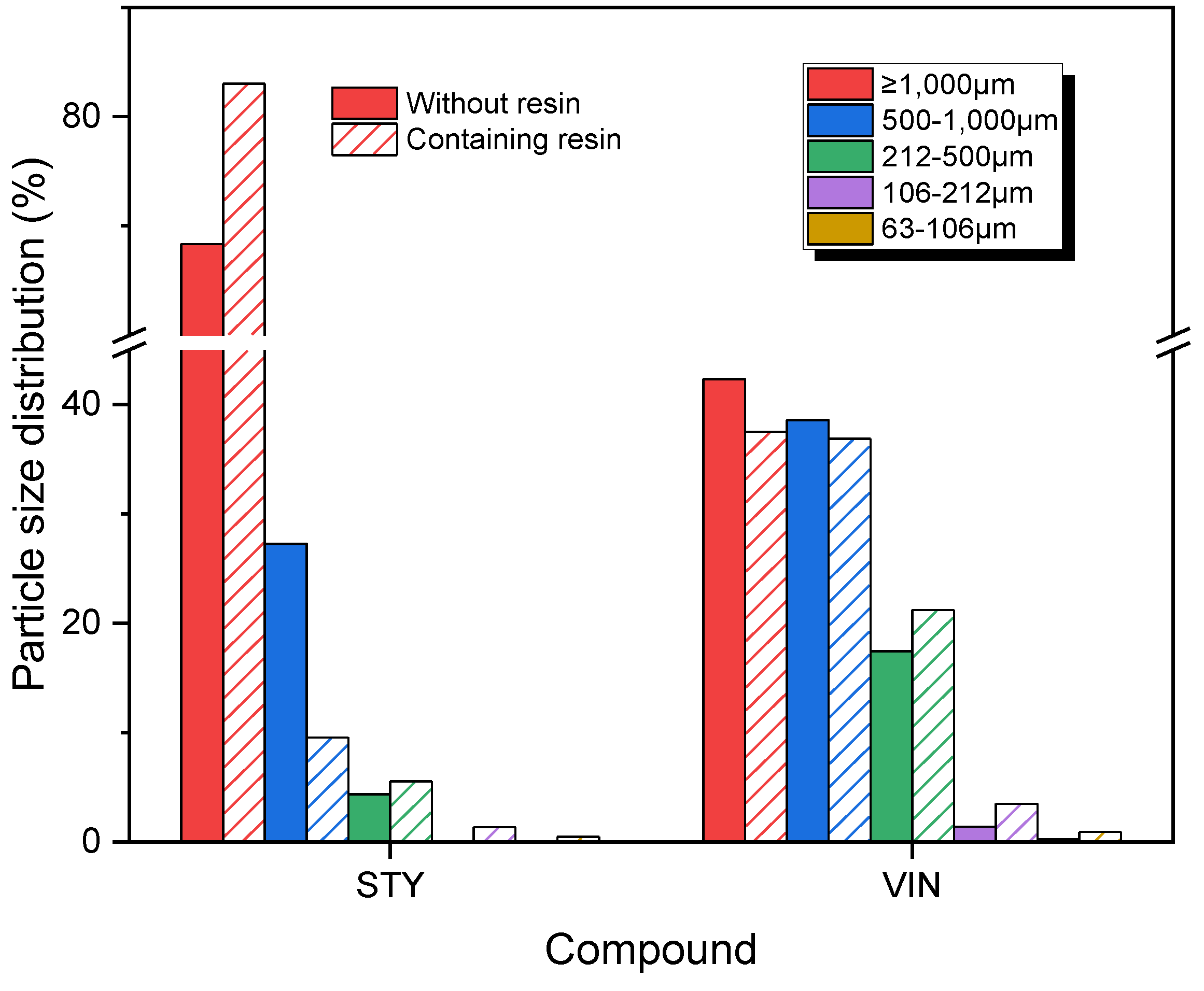Abrasion Behaviors of Silica-Reinforced Solution Styrene–Butadiene Rubber Compounds Using Different Abrasion Testers
Abstract
:1. Introduction
2. Materials and Methods
2.1. Preparation of Samples
2.2. Abrasion Tests
2.3. Analyses of Bound Rubber Contents and Crosslink Densities
3. Results and Discussion
3.1. Bound Rubber Contents, Crosslink Densities, and Tensile Properties
3.2. Abrasion Rates
3.3. Size Distributions and Morphologies of Wear Particles
3.4. Abrasion Patterns
4. Conclusions
Author Contributions
Funding
Institutional Review Board Statement
Data Availability Statement
Conflicts of Interest
References
- Torbati-Fard, N.; Hosseini, S.M.; Razzaghi-Kashani, M. Effect of the silica-rubber interface on the mechanical, viscoelastic, and tribological behaviors of filled styrene-butadiene rubber vulcanizates. Polym. J. 2020, 52, 1223–1234. [Google Scholar] [CrossRef]
- Sirisinha, C.; Sae-oui, P.; Suchiva, K.; Thaptong, P. Properties of tire tread compounds based on functionalized styrene butadiene rubber and functionalized natural rubber. J. Appl. Polym. Sci. 2020, 137, 48696. [Google Scholar] [CrossRef]
- Oleiwi, J.K.; Hamza, M.S.; Abed, M.S. Improving the properties of the tire tread by adding SiO2 and Al2O3 to SBR rubber. Int. J. Appl. Eng. Res. 2010, 5, 1637–1652. [Google Scholar]
- Choi, S.-S.; Park, B.-H.; Song, H. Influence of filler type and content on properties of styrene-butadiene rubber (SBR) compound reinforced with carbon black or silica. Polym. Adv. Technol. 2004, 15, 122–127. [Google Scholar] [CrossRef]
- Muhr, A.H.; Roberts, A.D. Rubber abrasion and wear. Wear 1992, 158, 213–228. [Google Scholar] [CrossRef]
- Zhu, J.; Han, K.; Wang, S. Automobile tire life prediction based on image processing and machine learning technology. Adv. Mech. Eng. 2021, 13, 16878140211002727. [Google Scholar] [CrossRef]
- Nguyen, V.H.; Zheng, D.; Schmerwitz, F.; Wriggers, P. An advanced abrasion model for tire wear. Wear 2019, 426–427, 37–48. [Google Scholar] [CrossRef]
- Wu, Y.P.; Zhou, Y.; Li, J.L.; Zhou, H.D.; Chen, J.M.; Zhao, H.C. A comparative study on wear behavior and mechanism of styrene butadiene rubber under dry and wet conditions. Wear 2016, 356–357, 1–8. [Google Scholar] [CrossRef]
- Sapragonas, J.; Kersys, A.; Makaras, R.; Lukosevicius, V.; Juodvalkis, D. Research of the influence of tire hydroplaning on directional stability of vehicle. Transport 2013, 28, 374–380. [Google Scholar] [CrossRef]
- Li, Y.; Zuo, S.; Lei, L.; Yang, X.; Wu, X. Analysis of impact factors of tire wear. J. Vib. Control 2012, 18, 833–840. [Google Scholar] [CrossRef]
- Nishi, T. Rubber wear mechanism discussion based on the relationship between the wear resistance and the tear resistance with consideration of the strain rate effect. Wear 2019, 426–427, 37–48. [Google Scholar] [CrossRef]
- Grigoratosa, T.; Gustafsson, M.; Eriksson, O.; Martini, G. Experimental investigation of tread wear and particle emission from tyres with different treadwear marking. Atmos. Environ. 2018, 182, 200–212. [Google Scholar] [CrossRef]
- Fukahori, Y.; Yamazaki, H. Mechanism of rubber abrasion. Part I: Abrasion pattern formation in natural rubber vulcanizate. Wear 1994, 171, 195–202. [Google Scholar] [CrossRef]
- Ren, Y.; Li, W.; Jia, Q.; Zhao, Y.; Qu, C.; Liu, L.; Liu, J.; Wu, C. Separation and quantification of tire and road wear particles in road dust samples: Bonded-sulfur as a novel marker. J. Hazard. Mater. 2024, 465, 133089. [Google Scholar] [CrossRef] [PubMed]
- Chae, E.; Jung, U.; Choi, S.-S. Types and concentrations of tire wear particles (TWPs) in road dust generated in slow lanes. Environ. Pollut. 2024, 346, 123670. [Google Scholar] [CrossRef] [PubMed]
- Chae, E.; Choi, S.-S. Quantification of road dust transfer to central lane bus stop from other lanes using tire tread rubber markers of bus and passenger vehicle through pyrolytic technique. J. Anal. Appl. Pyrolysis 2024, 179, 106493. [Google Scholar] [CrossRef]
- Jarlskog, I.; Jaramillo-Vogel, D.; Rausch, J.; Gustafsson, M.; Stromvall, A.-M.; Andersson-Skold, Y. Concentrations of tire wear microplastics and other traffic-derived non-exhaust particles in the road environment. Environ. Int. 2022, 170, 107618. [Google Scholar] [CrossRef] [PubMed]
- Jung, U.; Choi, S.-S. Characteristics in densities and shapes of various particles produced by friction between tire tread and road surface. Elast. Compos. 2022, 57, 92–99. [Google Scholar]
- Jung, U.; Choi, S.-S. A variety of particles including tire wear particles produced on the road. Elast. Compos. 2021, 56, 85–91. [Google Scholar]
- Baensch-Baltruschat, B.; Kocher, B.; Stock, F.; Reifferscheid, G. Tyre and road wear particles (TRWP)—A review of generation, properties, emissions, human health risk, ecotoxicity, and fate in the environment. Sci. Total Environ. 2020, 733, 137823. [Google Scholar] [CrossRef]
- Knight, L.J.; Parker-Jurd, F.N.F.; Al-Sid-Cheikh, M.; Thompson, R.C. Tyre wear particles: An abundant yet widely unreported microplastic? Environ. Sci. Pollut. Res. 2020, 27, 18345–18354. [Google Scholar] [CrossRef] [PubMed]
- Chae, E.; Yang, S.R.; Choi, S.-S. Characteristics in size distributions and morphologies of wear particles depending on types of abrasion testers. Elast. Compos. 2023, 58, 87–94. [Google Scholar]
- Chae, E.; Choi, S.-S. Influence of slip angle on abrasion behavior of NR/BR vulcanizates. Elast. Compos. 2023, 58, 17–25. [Google Scholar]
- Chae, E.; Yang, S.R.; Choi, S.-S. Test method for abrasion behavior of tire tread compounds using the wear particles. Polym. Test. 2022, 115, 107758. [Google Scholar] [CrossRef]
- Chae, E.; Yang, S.R.; Choi, S.-S. Abrasion behaviors of NR/BR compounds using laboratory abrasion tester. Elast. Compos. 2021, 56, 12–19. [Google Scholar]
- Elangovan, K.; Josephraj, F.X.; Murugesan, A.K.; Pandian, B. Effect of crosslink density on cut and chip resistance of 100% SBR based tire tread compound. Mater. Plast. 2021, 58, 34–46. [Google Scholar]
- Stocek, R.; Heinrich, G.; Kipscholl, R.; Kratina, O. Cut & chip wear of rubbers in a range from low up to high severity conditions. Appl. Surf. Sci. Adv. 2021, 6, 100152. [Google Scholar]
- Kim, H.; Jeon, I. Wear and frictional behavior of tire rubber. Polym. Sci. Technol. 2000, 11, 592–602. [Google Scholar]
- Go, J.H.; Nah, C. Wear of rubber for tire. Polym. Sci. Technol. 1995, 6, 348–357. [Google Scholar]
- ASTM D5963-22; Standard Test Method for Rubber Property—Abrasion Resistance (Rotary Drum Abrader). ASTM International: West Conshohocken, PA, USA, 2022.
- ISO 4649:2017; Rubber, Vulcanized, or Thermoplastic—Determination of Abrasion Resistance Using a rotating Cylindrical Drum Device. International Organization for Standardization: Geneva, Switzerland, 2017.
- Salehi, M.; Noordermeer, J.W.M.; Reuvekamp, L.A.E.M.; Tolpekina, T.; Blume, A. A new horizon for evaluating tire grip within a laboratory environment. Tribol. Lett. 2020, 68, 37. [Google Scholar] [CrossRef]
- Salehi, M.; Noordermeer, J.W.M.; Reuvekamp, L.A.E.M.; Dierkes, W.K.; Blume, A. Measuring rubber friction using a laboratory abrasion tester (LAT100) to predict car tire dry ABS braking. Tribol. Int. 2019, 131, 191. [Google Scholar] [CrossRef]
- Heinz, M.; Grosch, K.A. A laboratory method to comprehensively evaluate abrasion, traction and rolling resistance of tire tread compounds. Rubber Chem. Technol. 2007, 80, 580–607. [Google Scholar] [CrossRef]
- Song, S.; Jeong, J.; Kim, D.; Hwang, K.; Chung, S.; Kim, W. Effect of silica contents on the vulcanizates structure and physical properties in ENR/BR blend compounds. Elast. Compos. 2024, 59, 8–16. [Google Scholar]
- Choi, S.-S. Influence of blend ratios on dynamic properties of SBR/SBR biblended composites. Elast. Compos. 2024, 59, 17–21. [Google Scholar]
- Phumnok, E.; Khongprom, P.; Ratanawilai, S. Preparation of natural rubber composites with high silica contents using a wet mixing process. ACS Omega 2022, 7, 8364–8376. [Google Scholar] [CrossRef] [PubMed]
- Lolage, M.; Parida, P.; Chaskar, M.; Gupta, A.; Rautaray, D. Green silica: Industrially scalable & sustainable approach towards achieving improved “nano filler-elastomer” interaction and reinforcement in tire tread compounds. Sustain. Mater. Technol. 2020, 26, e00232. [Google Scholar]
- Hassan, A.A.; Formela, K.; Wang, S. Enhanced interfacial and mechanical performance of styrene-butadiene rubber/silica composites compatibilized by soybean oil derived silanized plasticization. Compos. Sci. Technol. 2020, 197, 108271. [Google Scholar] [CrossRef]
- Van Hoek, J.W.; Heideman, G.; Noordermeer, J.W.M.; Dierkes, W.K.; Blume, A. Implications of the use of silica as active filler in passenger car tire compounds on their recycling options. Materials 2019, 12, 725. [Google Scholar] [CrossRef] [PubMed]
- Gui, Y.; Zheng, J.; Ye, X.; Han, D.; Xi, M.; Zhang, L. Preparation and performance of silica/SBR master batches with high silica loading by latex compounding method. Compos. B Eng. 2016, 85, 130–139. [Google Scholar] [CrossRef]
- Bernal-Ortega, P.; Gaillard, E.; Elburg, F.; Blume, A. Use of hydrocarbon resins as an alternative TDAE oil in tire tread compounds. Polym. Test. 2023, 126, 108168. [Google Scholar] [CrossRef]
- Chae, E.; Yang, S.R.; Cho, S.H.; Choi, S.-S. Influence of dicyclopentadiene resin on abrasion behavior of silica-filled SBR compounds using different abrasion testers. Elast. Compos. 2023, 58, 103–111. [Google Scholar]
- Shee, B.; Chanda, J.; Dasgupta, M.; Sen, A.K.; Bhattacharyya, S.K.; Gupta, S.D.; Mukhopadhyay, R. A study on hydrocarbon resins as an advanced material for performance enhancement of radial passenger tyre tread compound. J. Appl. Polym. Sci. 2022, 139, 51950. [Google Scholar] [CrossRef]
- Yun, Y.M.; Lee, J.H.; Choi, M.C.; Kim, J.W.; Kang, H.M.; Bae, J.W. A study on the effect of petroleum resin on vibration damping characteristics of natural rubber composites. Elast. Compos. 2021, 56, 201–208. [Google Scholar]
- Indriasari; Noordermeer, J.; Dierkes, K. Incorporation of oligomeric hydrocarbon resins for improving the properties of aircraft tire retreads. Appl. Sci. 2021, 11, 9834. [Google Scholar] [CrossRef]
- Hsu, H.-C.; Wang, S.-J.; Di-Yi Ou, J.; Wong, D.S.H. Simplification and intensification of a C5 separation process. Ind. Eng. Chem. Res. 2015, 54, 9798–9804. [Google Scholar] [CrossRef]
- Zohuriaan-Mehr, M.J.; Omidian, H. Petroleum resins an overview. J. Macromol. Sci. 2000, 40, 23–49. [Google Scholar] [CrossRef]
- Berahman, B.; Dabir, B.; Sadeghpour, S. Simulation of the C5 aliphatic petroleum resins production process. Petrol. Sci. Technol. 2010, 28, 1277–1286. [Google Scholar] [CrossRef]
- Stocek, R.; Mars, W.V.; Kipscholl, R.; Robertson, C.G. Characterisation of cut and chip behaviour for NR, SBR and BR compounds with an instrumented laboratory device. Plast. Rubber Compos. 2019, 48, 14–23. [Google Scholar] [CrossRef]
- Choi, S.-S.; Kim, J.-C. Lifetime prediction and thermal aging behaviors of SBR and NBR composites using crosslink density changes. J. Ind. Eng. Chem. 2012, 18, 1166–1170. [Google Scholar] [CrossRef]
- Choi, S.-S.; Han, D.-H. Strain effect on recovery behaviors from circular deformation of natural rubber vulcanizate. J. Appl. Polym. Sci. 2009, 114, 935–939. [Google Scholar] [CrossRef]
- Flory, P.J. Statistical mechanics of swelling of network structures. J. Chem. Phys. 1950, 18, 108–111. [Google Scholar] [CrossRef]
- Choi, S.-S.; Ko, E. Novel test method to estimate bound rubber formation of silica-filled solution styrene-butadiene rubber compounds. Polym. Test. 2014, 40, 170–177. [Google Scholar] [CrossRef]
- Jang, S.-H.; Kim, W.-S.; Kang, Y.-G.; Han, M.-H.; Chang, S.-M. Study on mixing condition of the rubber composite containing functionalized S-SBR, silica and silane; II. Effect of mixing temperature and time. Elast. Compos. 2013, 48, 103–113. [Google Scholar] [CrossRef]
- Choi, S.-S.; Kwon, H.-M.; Kim, Y.; Ko, E.; Lee, K.-S. Hybrid factors influencing on wet grip and rolling resistance properties of solution styrene-butadiene rubber composites. Polym. Int. 2018, 67, 340–346. [Google Scholar] [CrossRef]
- Son, C.E.; Choi, S.-S. Analytical techniques for measurement of crosslink densities of rubber vulcanizates. Elast. Compos. 2019, 54, 209–219. [Google Scholar]
- Zhao, F.; Bi, W.; Zhao, S. Influence of crosslink density on mechanical properties of natural rubber vulcanizates. J. Macromol. Sci. B 2011, 50, 1460–1469. [Google Scholar] [CrossRef]
- Choi, S.-S.; Kim, I.-S.; Woo, C.-S. Influence of TESPT content on crosslink types and rheological behaviors of natural rubber compounds reinforced with silica. J. Appl. Polym. Sci. 2007, 106, 2753–2758. [Google Scholar] [CrossRef]
- Coran, A.Y. Vulcanization: Conventional and dynamic. Rubber Chem. Technol. 1995, 68, 351–375. [Google Scholar] [CrossRef]
- De Oliveira, T.; Muresan, B.; Ricordel, S.; Lumiere, L.; Truong, X.-T.; Poirier, L.; Gasperi, J. Realistic assessment of tire and road wear particle emissions and their influencing factors on different types of roads. J. Hazard. Mater. 2024, 465, 133301. [Google Scholar] [CrossRef]
- Kovochich, M.; Liong, M.; Parker, J.A.; Oh, S.C.; Lee, J.P.; Xi, L.; Kreider, M.L.; Unice, K.M. Chemical mapping of tire and road wear particles for single particle analysis. Sci. Total Environ. 2021, 757, 144085. [Google Scholar] [CrossRef]









| Compound | STY | STYR | VIN | VINR |
|---|---|---|---|---|
| SSBR1 | 137.5 | 137.5 | --- | --- |
| SSBR2 | --- | --- | 100.0 | 100.0 |
| Silica (7000Gr) | 80.0 | 80.0 | 80.0 | 80.0 |
| Silane (X-50S) | 8.0 | 8.0 | 8.0 | 8.0 |
| DPG | 1.6 | 1.6 | 1.6 | 1.6 |
| Zinc oxide | 4.0 | 4.0 | 4.0 | 4.0 |
| Stearic acid | 3.0 | 3.0 | 3.0 | 3.0 |
| 6PPD | 2.0 | 2.0 | 2.0 | 2.0 |
| TMQ | 1.0 | 1.0 | 1.0 | 1.0 |
| Wax | 1.0 | 1.0 | 1.0 | 1.0 |
| TDAE oil | 5.0 | 5.0 | 42.5 | 42.5 |
| DCPD resin | --- | 20.0 | --- | 20.0 |
| Sulfur | 1.6 | 1.6 | 1.6 | 1.6 |
| TBBS (NS) | 1.1 | 1.1 | 1.1 | 1.1 |
| Compound | STY | STYR | VIN | VINR |
|---|---|---|---|---|
| Bound rubber content (%) | 47.1 | 46.7 | 76.0 | 75.4 |
| Crosslink density (10−5 mol cm−3) | 6.63 | 6.22 | 5.41 | 4.85 |
| Physical Property | STY | STYR | VIN | VINR |
|---|---|---|---|---|
| 100% modulus (MPa) | 1.55 | 1.29 | 1.27 | 0.99 |
| 200% modulus (MPa) | 3.16 | 2.55 | 2.34 | 1.79 |
| 300% modulus (MPa) | 5.59 | 4.39 | 4.06 | 2.94 |
| 400% modulus (MPa) | 8.65 | 6.74 | 6.54 | 4.62 |
| 500% modulus (MPa) | 12.01 | 9.36 | 9.52 | 6.76 |
| Elongation at break (%) | 648 | 702 | 538 | 472 |
| Tensile strength (MPa) | 22.23 | 22.55 | 18.13 | 14.57 |
| Compound | Abrasion Tester | |||
|---|---|---|---|---|
| Cut and Chip | Lambourn | DIN | LAT100 | |
| STY | 92 | 59 | 106 | 7 |
| STYR | 78 | 51 | 182 | 3 |
| VIN | 70 | 77 | 61 | 69 |
| VINR | 15 | 52 | --- | 4 |
Disclaimer/Publisher’s Note: The statements, opinions and data contained in all publications are solely those of the individual author(s) and contributor(s) and not of MDPI and/or the editor(s). MDPI and/or the editor(s) disclaim responsibility for any injury to people or property resulting from any ideas, methods, instructions or products referred to in the content. |
© 2024 by the authors. Licensee MDPI, Basel, Switzerland. This article is an open access article distributed under the terms and conditions of the Creative Commons Attribution (CC BY) license (https://creativecommons.org/licenses/by/4.0/).
Share and Cite
Chae, E.; Yang, S.R.; Choi, S.-S. Abrasion Behaviors of Silica-Reinforced Solution Styrene–Butadiene Rubber Compounds Using Different Abrasion Testers. Polymers 2024, 16, 2038. https://doi.org/10.3390/polym16142038
Chae E, Yang SR, Choi S-S. Abrasion Behaviors of Silica-Reinforced Solution Styrene–Butadiene Rubber Compounds Using Different Abrasion Testers. Polymers. 2024; 16(14):2038. https://doi.org/10.3390/polym16142038
Chicago/Turabian StyleChae, Eunji, Seong Ryong Yang, and Sung-Seen Choi. 2024. "Abrasion Behaviors of Silica-Reinforced Solution Styrene–Butadiene Rubber Compounds Using Different Abrasion Testers" Polymers 16, no. 14: 2038. https://doi.org/10.3390/polym16142038





